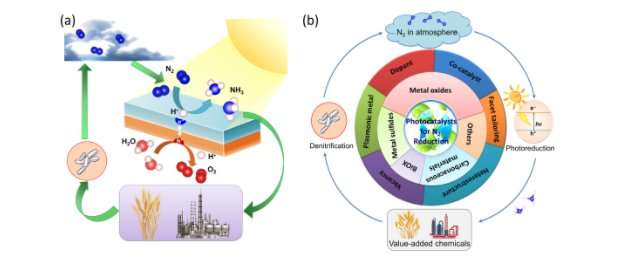Photochemical nitrogen fixation—opening new vistas toward a sustainable energy future

How can a photocatalyst convert nitrogen to ammonia using water and light? With international collaboration, researchers from China and Singapore have looked into state-of-the-art engineering of photocatalysts for nitrogen (N2) fixation toward understanding ammonia (NH3) synthesis. The work has been reported in Materials Horizons.
N2 is one of the most abundant gases on Earth, comprising 78 percent of the atmosphere. Nevertheless, N2 in the gaseous state cannot be efficiently utilized by most organisms. Therefore, N2 must be "fixed" to make it useful by breaking the ultra-strong N≡N triple bonds to transform it into a form that can be consumed by plants, animals and human beings. To date, there are two typical methods to realize the fixation of N2. One is a natural and bacterial process, and another, the Haber-Bosch process, is synthetic. For the past 100 years, the N2 conversion has led to the large-scale production of fertilizer and sustained the supply of food intake for global population.
"The Haber-Bosch process utilizes high temperatures and pressures, thus necessitating a massive amount (around 2 percent) of the world's fossil fuel supply. Therefore, we envision that an alternative process employing nanomaterials that absorbs light energy to mimic the natural photosynthesis in plants could serve as a paradigm shift for fixing nitrogen," said Dr. Wee-Jun Ong, a research scientist from the Institute of Materials Research and Engineering (IMRE).
"Compared to the thermochemical catalytic process, artificial photosynthesis is regarded as a sustainable route in storing renewable solar energy in the form of energy-dense chemical products," Ong said. "The thermodynamic non-spontaneous reaction can be achieved via a combination of water splitting and N2 reduction over a photocatalyst in the presence of solar light," he explained.
In a recent paper appearing in Materials Horizons, Ong and his colleagues present a progress report of photocatalytically fixing N2, which is naturally sparked by the action of microbes. "We classify the photocatalysts based on the chemical compositions ranging from metal oxide to metal sulfide, bismuth oxyhalides, carbonaceous nanomaterials and other potential materials. We highlight the importance and relationship between the modification—e.g. nanoarchitecture design, crystal facet engineering, doping, and heterostructuring—and influences on the photocatalytic activity of the designed catalysts," notes Xingzhu Chen, the paper's first author, who sums up the findings.
"Judging from the existing literature in this research platform at this juncture, computer-aided catalysts designed via quantum-chemical calculations for the N2 photofixation would be a robust tool for simulating electronic states and reaction pathways toward excellent sunlight absorption and the selective performance of catalysis," Ong said.
Even though there are many factors hindering the cleavage and hydrogenation of N2 at present, reaction conditions have become milder over the years—air and visible light were gradually adopted as the nitrogen and light source instead of pure nitrogen and ultraviolet (UV) irradiation. However, insights into the photocatalytic reaction mechanism have been inadequate up to now, despite the complexity of the N2 fixation reaction. "Advanced in situ or operando characterization techniques are necessary to examine the atomic insights in reactivity as well as to understand the excited-state charge carrier dynamics," Ong said.
What's next? Researchers hope to translate from the laboratory-scale level to industrial applications, and amplify the yield of catalysts while maintaining the intrinsic structures for the commercialization of renewable ammonia.
Dr. Ong said, "Looking at the long-term prospects, we are certain that our work will provide an important basis for the next research era not only in the photocatalytic N2 fixation specifically, but also in the interdisciplinary fields of chemistry, materials science, energy conversion and energy storage."
Apart from solar-driven N2 fixation, Dr. Ong, Prof. Li and their teams have been searching for the smart design of photocatalysts that can render H2O splitting and CO2 reduction more effective and sustainable through solar energy via experimental and computational analyses. Work on solar-to-energy fuels conversion is underway.
More information: Xingzhu Chen et al. Photocatalytic fixation of nitrogen to ammonia: state-of-the-art advancements and future prospects, Mater. Horiz. (2017). DOI: 10.1039/C7MH00557A



















